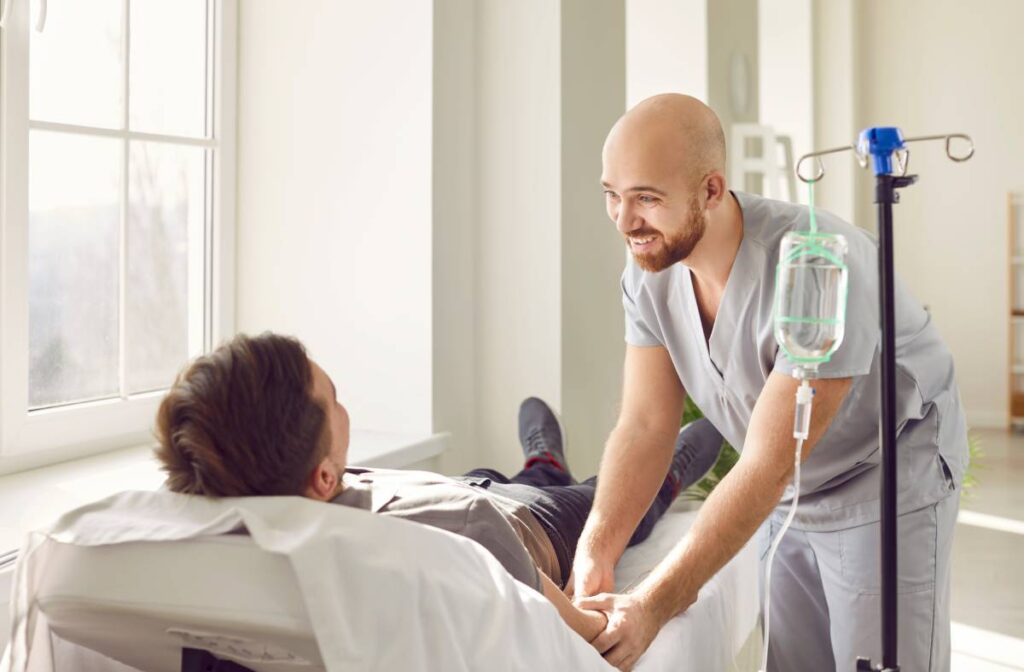Intravenous (IV) extravasation, the unintentional leakage of injected drugs from blood vessels into the surrounding tissue, is a potential complication during surgical procedures. This complication can result in a range of adverse outcomes, from mild irritation to severe tissue necrosis (1). The prevention and management of IV extravasation requires a multifaceted approach that integrates careful venipuncture site selection, continuous monitoring, and prompt, effective interventions.
The first step for prevention of IV extravasation involves judicious selection of the venipuncture site. In order to reduce the risk of catheter movement and subsequent dislodgement, it is preferable to use veins that are well supported by surrounding tissues and are away from joints (2). In cases where vesicant or irritant drugs are administered (which pose a higher risk of causing tissue damage upon extravasation), the use of central venous catheters may be advisable, especially in patients with compromised peripheral venous access or those requiring long-term infusion therapy (1). Furthermore, continuous monitoring of the infusion site is crucial for early detection and management of IV extravasation. Anesthesia providers should be trained to recognize early signs and symptoms, such as swelling, redness, pain, or a decrease in the infusion rate, which could indicate the occurrence of extravasation. Regular inspection and palpation of the infusion site, coupled with attention to patient-reported symptoms, can help prevent extravasation (3).
Upon identification of IV extravasation, immediate steps should be taken for its management. The infusion must be stopped promptly to prevent further leakage, and attempts should be made to aspirate and retrieve the extravasated fluid from the catheter. Additionally, elevating the affected limb can help reduce edema and discomfort. Depending on the type of substance extravasated, the use of cold or warm compresses can help alleviate local tissue reactions (2). Cold packs are generally recommended for extravasations involving vesicants to limit local blood flow and reduce the spread of the substance, whereas warm compresses may be used for irritants to enhance blood flow and dilute the extravasated agent (3).
In certain cases of IV extravasation, it may be necessary to administer specific antidotes or neutralizing agents directly into the affected area for proper management. Hyaluronidase, for example, has been effectively used to treat extravasations involving vesicant drugs by facilitating the dispersion of the extravasated substance, thereby minimizing tissue damage (3). The use of antidotes should be guided by the nature of the extravasated substance and evidence-based protocols. In severe cases of IV extravasation where conservative management fails or there is evidence of progressing tissue damage, surgical consultation may be necessary. Surgical intervention might be required to debride necrotic tissue or relieve compartment syndrome, a serious condition resulting from increased pressure within a confined muscle space (4). Comprehensive documentation of the extravasation incident is essential to inform subsequent care and facilitate quality improvement initiatives. Details such as the drug involved, the estimated volume of extravasation, and the interventions undertaken should be meticulously recorded (3).
Prevention and management of IV extravasation requires a proactive, multidisciplinary approach. Through careful site selection, diligent monitoring, and prompt, appropriate interventions, providers can significantly reduce the incidence of IV extravasation and mitigate its consequences, ensuring patient safety and optimizing outcomes.
References
- Hadaway L. Infiltration and extravasation. Am J Nurs. 2007;107(8):64-72. doi:10.1097/01.NAJ.0000282299.03441.c7
- Schummer W, Schummer C, Bayer O, Müller A, Bredle D, Karzai W. Extravasation injury in the perioperative setting. Anesth Analg. 2005;100(3):722-727. doi:10.1213/01.ANE.0000143397.25251.19
- Kim ES, Park BR. Guidelines for the management of extravasation. J Educ Eval Health Prof. 2020;17:21. doi:10.3352/jeehp.2020.17.21.
- Dougherty L. Extravasation: prevention, recognition and management. Nurs Stand. 2010 Sep;24(52):48-55. doi:10.7748/ns2010.09.24.52.48.c7956.



